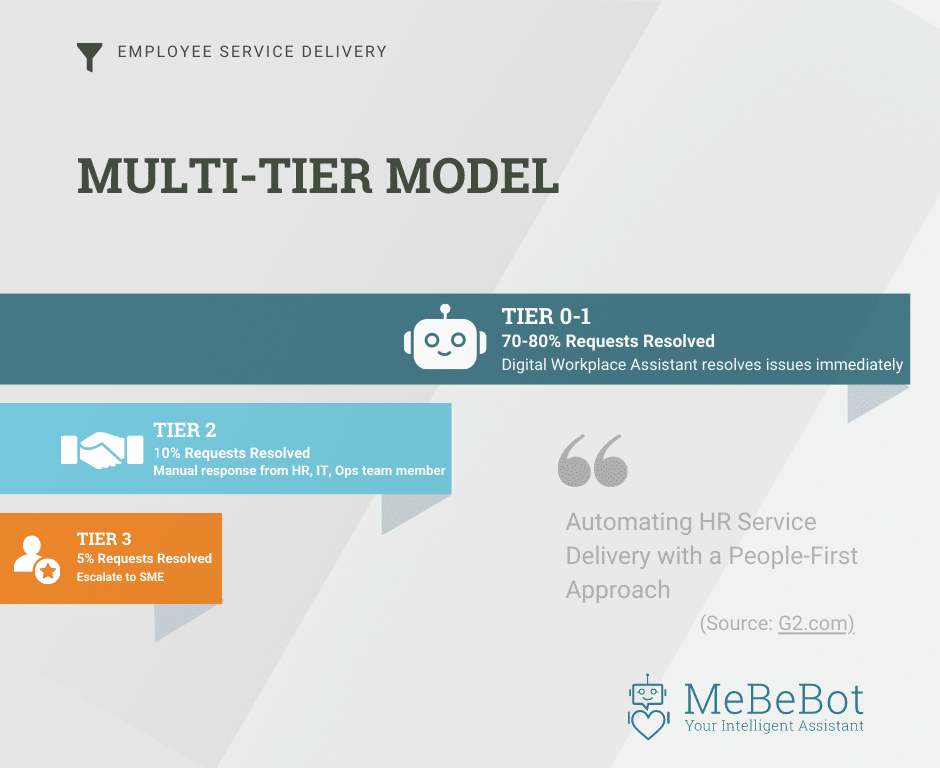What is Employee Support Delivery?
The workplace is entering 2023 amid employees trying to adapt and navigate the impacts of return-to-the-office, hybrid work schemes, and layoffs. Simultaneously, companies are creatively focused on hiring and seeking ways to squeeze more productivity out of fewer resources within limited budgets.
This level of change within workplaces can negatively impact employee experiences — prioritizing change management (or change agility) is a must. The macro forces of consistent layoff news, low unemployment rates, and record job openings cause talent retention to be top of mind. And making employee experience initiatives key to organizational success becomes a top priority.
In a recent article, Minda Zetlin stated, “When times are bad, you eliminate the nonessential and focus your creative effort on making the best use of every resource you have.” Zetlin’s quote is the anthem of front-line teams supporting the employee experience – IT, Facilities, Payroll, and Human Resources. But are these teams set up to successfully utilize their resources and support employees’ needs globally?
Often, these teams spend most of their time stuck in the “administrative weeds” of manual processes, trying to meet the basic foundational needs of the employees they support and frequently missing the mark. A primary factor holding these support functions back is that they are working with an employee service delivery model that needs to be updated and centralized.
Multi-Tiered Employee Support Delivery.
While IT is familiar with multi-tiered employee service delivery, Human Resources must catch up. The tiers of employee service delivery typically are:
Tier 0 – Employee Self-Service. Self-service technology allows employees to search for their information to troubleshoot and find solutions without contacting support functions directly.
Tier 1 – Question Routing – Employees cannot find the necessary information, and they direct their questions through a ticketing system, email distribution group, or appropriate communication channel. Requests are routed to the proper support function. If the request requires specific knowledge to resolve, it is routed to the next tier.
Tier 2 – Subject Matter Expert – Employee requests are assigned to the appropriate subject expert for review and resolution. If the request is more complex, it is routed to the next tier.
Tier 3 – Intervention Specialist – Employee request requires direct interaction or intervention from a strategic professional to take multiple steps to resolve.

Today’s Support Delivery Structure.
Currently, workplaces have an employee delivery service that needs to be more cohesive and clearer. Tier 0 through 1 support for IT often provides employees with a more robust automated solution than the other support functions. Employees often can go to a portal to review easily accessible information to troubleshoot their concerns. If they need additional help, a ticket request can be submitted, and a dashboard may be available for employees to review the status of their requests. While employees can obtain information in this method, they may not be able to provide feedback on the quality of experience to the IT team.
Let’s suppose employees have questions outside IT, such as facilities, payroll, or HR. There may be a Tier 0 Intranet site with static documents spread across several department web pages. Or, there may be the ability to search for keywords in Slack or Microsoft teams across multiple channels, which provides minimal results. It is not surprising that MeBeBot’s customer research indicates that employees spend 30% of their workday searching for information and 60% of employees need more time and understanding to find the information required. As a result, employees often bypass Tier 0 and jump to Tier 1 once they find the right email distribution group (@payroll, @HR, @facilities) or communication channel. Then employees are left alone, waiting for a response.
Tier 1 support is often where the service delivery model stops or gets stuck. For example, employee emails may get lost as they are passed between support function team members. Or a Slack request will go unanswered. This is when HR often gets stuck in firefighting mode, answering routine questions. What are some possible outcomes of an outdated service model? Delayed medical coverage for the birth of a new baby, new people managers incorrectly navigating employee relations issues, inconsistent advice provided on a benefits issue, and a potential negative employee tax implication for a payroll error.
4 Transformations Needing To Happen To The Employee Support Delivery.
- We need a delivery model that centralizes our support functions to streamline the employee experience as a shared one-team responsibility.
- The service delivery model needs the right technology to automate and support a multi-tiered approach.
- We need digital solutions that enable workplaces to evolve their Tier 0 through 1 support to incorporate a human-centered approach.
- These solutions need to provide a way to meaningfully connect with employees, provide automated tailored real-time support, and collect data from employees on that experience’s quality. Support teams can then use that feedback for continuous improvement.
Change And Uncertainty Are The New Normal For The Workplaces.
What is unknown to us is easy to reject as humans. We need to be aware of what may be causing us to hold onto the past, which, if we remember, was riddled with the same problems we face today. We must lean into change and rethink our current employee service delivery model to impact employee engagement positively. The ability to keep and attract talent relies on workplaces getting this right. We need to invest and involve our AI workplace solutions that are easy to maintain and affordable, to support and evolve our employee service delivery model. If this is done, organizations will be able to maximize every resource. Different tools and ways of working need to be adopted to get out of the weeds and focus on work that will enable our organizations to continue to thrive in the future.
Schedule a demo today to learn how AI Intelligent Assistants work to simplify the employee experience.

